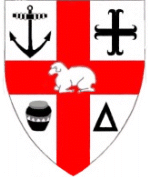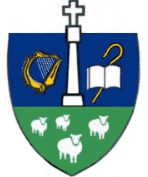Themes – farm animals
To learn more about the arms illustrated, click on the images.
FARM animals cover a wide range of species, especially nowadays when many farmers have gone in for keeping wild game (see here and here for examples). But while game animals often feature in coat-armour, the same cannot be said for the domesticated variety. Currently on Armoria, only a handful are to be found. Firstly there are the rams Beaufort West has for its supporters: dexter a merino, and sinister an Angora goat – both important in the economy of the Karoo, the merino producing fine wool as well as meat, and the Angora for its mohair. A third farm animal appears in the town’s crest, namely an ostrich. But since it is a bird, you will find that species here.
Sheep also appear in the seal of the Oranje Vrij Staat, signifying the drier grazing conditions of the western parts, compared with the wetter Highveld of the northern Free State.
More a religious symbol than strictly a farm animal is the lamb (also, by the looks of it, a merino) found in the arms of the Diocese of Port Elizabeth, which represents Christ as the Lamb of God. A related symbolism is found in the four sheep – symbolising a much larger flock – in the arms of Bishop Michael Coleman of Port Elizabeth, which recalls Christ’s injunction to Peter to “feed My lambs”. In addition the arms contain a pastoral staff, as used by both shepherds and bishops.


The only other farm animals currently found on Armoria are indigenous cattle. The indigenous breeds of Southern Africa are all descended from the herds of the Khoikhoi, who – possibly as long ago as 2 000 years – acquired cattle and a cattle culture from a Nilotic people near the Zambezi River. These they brought southwards, also providing cattle and cattle culture to the Bantu-speaking peoples who entered the country later. The best-known among these types is die Nguni breed. The best-known individual Nguni animal found in a coat of arms is the ox included the arms of Ciskei as a symbol of the Christians among the amaRharhabe (western Xhosa) people in memory of the prophet Ntsikana, who had a favourite ox. Other ox- or bull-heads are to be found in the arms of Bophuthatswana and Transkei.
I do not currently have an example of authentic Khoikhoi cattle, but already in the early days of the Cape settlement the Dutch-speaking Boers had begun crossing Khoikhoi cattle with imported breeds. The result was the sturdy Africander breed which provided the trek-oxen of the Trekboere and the Voortrekkers. Thabazimbi has the head and shoulders of an Africander bull in its arms.
There is a horse – known to have been a farm animal – in the arms of Woodstock. It was named Vonk, and it belonged to Wolraad Woltemade. Another horse, this time illustrated as part of a statue, is found in the crest of Rhodes University, which portrays a favourite statue of Cecil John Rhodes, titled Physical Energy.
Back to top of page
Back to themes index
Back to Armoria index
Comments, queries: Mike Oettle



